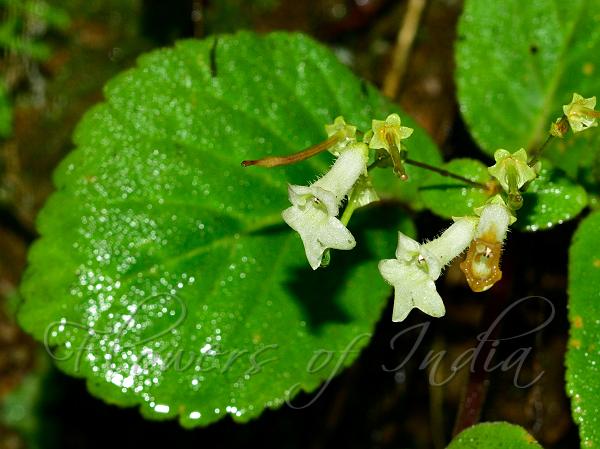|
| East-Indian Stone Flower |
|

|

| File size | 783024 |
| Original date | 8/24/18 9:59 AM |
| Resolution | 6000 x 4000 |
| Flash | Flash fired, return detected |
| Focal length | 60.0mm |
| Exposure time | 1/200s |
| Aperture | 10.0 |
| Focus Distance | |
| Metering Mode | Spot |
| Camera make | NIKON CORPORATION |
| Camera model | NIKON D7200 |
| Sensor type | OneChipColorArea |
|
|
|
|
Photo: |
Botanical name: Didymocarpus hookeri Family: Gesneriaceae (Gloxinia family)
Synonyms: Roettlera hookeri
Synonyms: Roettlera hookeri
East-Indian Stone Flower is a perennial, 7-20 cm tall
(including inflorescence), growing among rocks. Stem is erect, densely
appressed velvet-hairy, green-purplish. Leaves are in 2-4 pairs on
stem; lower one usually in whorl of 4, sometimes 3, of varying types,
long-stalked; middle and uppers opposite, usually same form, sometimes
of different form, nearly stalkless or short-stalked; blade
ovate-elliptic or broadly ovate-broadly elliptic, 3.5-20 x 2.5-10 cm,
tip pointed to blunt, sometimes rounded, base somewhat heart-shaped or
oblique, margins bi-rounded toothed or bi-sawtoothed, both surfaces
appressed velvet-hairy, midrib with 5-9 lateral veins on each side,
depressed above, raised below; leaf-stalks 1-12 cm long,
green-purplish. Inflorescences are 2-5, 8-28-flowered, at branch-end
cymes, rarely 1 or 2 in leaf-axil cymes from second uppermost leaves,
each cymule pair-flowered. Flower-cluster-stalk is 2-5 cm long, green
or with light purplish tinge; flower-stalks 3.5-7 mm long, sparsely
glandular velvet-hairy, green or with light purplish tinge; bracts 2,
free, broadly ovate, 2.5-4 mm long, light green. Sepal-cup is
bell-shaped, hairless inside and outside, eglandular, light green; tube
2.5-4 mm long; sepals 5, triangular-ovate, 2-3.5 mm long, equal or
subequal, tip pointed, margins entire. Flowers are white-creamy,
glandular velvet-hairy outside, hairless inside; tube 2.5-3 cm long,
tubular, slightly constricted in the middle, gradually widening above
the middle, limb 2-lipped; upper lip 2-lobed, broadly ovate-triangular,
3.5-4.5 mm long; lower lip 3-lobed, oblong- ovate, 5-7 mm long. Stamens
are 2, inserted near the middle of the flower tube; filaments 6-8 mm
long; staminodes 3, 1-2 mm long. Style is 6-8 mm long, hairless.
Capsules are linear, 3-4 cm long, hairless. East-Indian Stone Flower is
endemic to NE India, found up to altitudes of 1600-2000 m. Flowering:
June-October.
| Identification credit: Dipankar Borah | Photographed en-route to Cherapunjee, Meghalaya. |
• Is this flower misidentified? If yes,